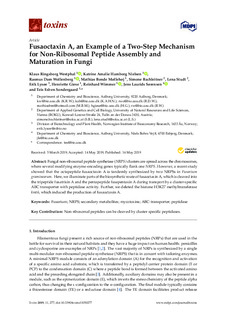| dc.contributor.author | Westphal, Klaus Ringsborg | |
| dc.contributor.author | Nielsen, Katrine Amalie Hamborg | |
| dc.contributor.author | Wollenberg, Rasmus Dam | |
| dc.contributor.author | Møllehøj, Mathias Bonde | |
| dc.contributor.author | Bachleitner, Simone | |
| dc.contributor.author | Studt, Lena | |
| dc.contributor.author | Lysøe, Erik | |
| dc.contributor.author | Giese, Henriette | |
| dc.contributor.author | Wimmer, Reinhard | |
| dc.contributor.author | Sørensen, Jens Laurids | |
| dc.contributor.author | Sondergaard, Teis Esben | |
| dc.date.accessioned | 2019-11-11T13:35:13Z | |
| dc.date.available | 2019-11-11T13:35:13Z | |
| dc.date.created | 2019-05-21T10:52:29Z | |
| dc.date.issued | 2019-05-16 | |
| dc.identifier.citation | Toxins. 2019, 11 (5), . | nb_NO |
| dc.identifier.issn | 2072-6651 | |
| dc.identifier.uri | http://hdl.handle.net/11250/2627757 | |
| dc.description.abstract | Fungal non-ribosomal peptide synthetase (NRPS) clusters are spread across the chromosomes, where several modifying enzyme-encoding genes typically flank one NRPS. However, a recent study showed that the octapeptide fusaoctaxin A is tandemly synthesized by two NRPSs in Fusarium graminearum. Here, we illuminate parts of the biosynthetic route of fusaoctaxin A, which is cleaved into the tripeptide fusatrixin A and the pentapeptide fusapentaxin A during transport by a cluster-specific ABC transporter with peptidase activity. Further, we deleted the histone H3K27 methyltransferase kmt6, which induced the production of fusaoctaxin A. | nb_NO |
| dc.language.iso | eng | nb_NO |
| dc.rights | Navngivelse 4.0 Internasjonal | * |
| dc.rights.uri | http://creativecommons.org/licenses/by/4.0/deed.no | * |
| dc.subject | Fusarium | nb_NO |
| dc.subject | NRPS | nb_NO |
| dc.subject | Secondary metabolites | nb_NO |
| dc.subject | Mycotoxins | nb_NO |
| dc.subject | ABC-transporter | nb_NO |
| dc.subject | Peptidase | nb_NO |
| dc.title | Fusaoctaxin A, an Example of a Two-Step Mechanism for Non-Ribosomal Peptide Assembly and Maturation in Fungi | nb_NO |
| dc.type | Journal article | nb_NO |
| dc.type | Peer reviewed | nb_NO |
| dc.description.version | publishedVersion | nb_NO |
| dc.rights.holder | © 2019 by the authors. | nb_NO |
| dc.subject.nsi | VDP::Landbruks- og Fiskerifag: 900::Landbruksfag: 910::Planteforedling, hagebruk, plantevern, plantepatologi: 911 | nb_NO |
| dc.source.pagenumber | 12 | nb_NO |
| dc.source.volume | 11 | nb_NO |
| dc.source.journal | Toxins | nb_NO |
| dc.source.issue | 5 | nb_NO |
| dc.identifier.doi | 10.3390/toxins11050277 | |
| dc.identifier.cristin | 1699020 | |
| dc.relation.project | Andre: NNF15OC0016186 - NovoNordisk Foundation | nb_NO |
| dc.relation.project | Andre: F-3703, M2149-B22 - Austrian Science Fund | nb_NO |
| dc.relation.project | Andre: SC16-026 - NFB—NÖ Forschung und Bildung | nb_NO |
| cristin.unitcode | 7677,3,0,0 | |
| cristin.unitname | Divisjon for bioteknologi og plantehelse | |
| cristin.ispublished | true | |
| cristin.fulltext | original | |
| cristin.qualitycode | 1 | |

